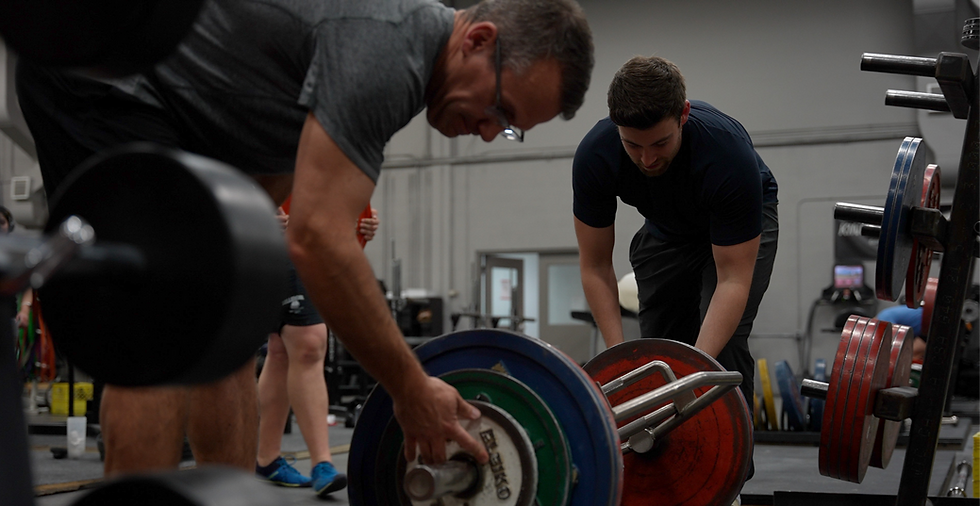Progressive Overload Beyond Just Weight: Volume, Density, Tempo, and Range of Motion
- Luke Bialobzyski, CSEP-CPT

- Oct 14
- 4 min read
Updated: Oct 29
As a personal trainer in Edmonton and through my online coaching, I often hear a version of this question:

“I keep lifting the same weights—does that mean I’m not progressing?”
Most people think progressive overload just means adding more weight to the bar. And yes, lifting heavier is a great way to grow. But if that’s the only lever you pull, you’ll eventually stall.
The real key is understanding that progressive overload has many forms - volume, density, tempo, and even range of motion. Let’s break them down and see how you can use each one to keep building strength and muscle.
The Science: Why Progressive Overload Works
Muscle grows because it adapts to stress. When you place a new demand on the body, your muscles, connective tissues, and nervous system respond by getting stronger.
Traditionally, this is explained as lifting heavier weights over time. But research shows that manipulating other variables—like total reps, rest time, or speed of contraction, also drives hypertrophy (Schoenfeld, Grgic, Ogborn, & Krieger, 2019).
Think of overload as a toolbox, not a single wrench.
Beyond Weight: The Four Levers
Volume (Sets × Reps × Weight)
Increasing the total work you do is one of the strongest predictors of hypertrophy (Schoenfeld et al., 2019).
Example: instead of 3×10 at 100 lbs (3,000 lbs total volume), try 4×10 at 100 lbs (4,000 lbs).
Density (Work ÷ Time)
Doing the same work in less time increases training density, which elevates both metabolic stress and cardiovascular demand (Schoenfeld, 2010).
Example: If you finish your workout in 45 minutes instead of 60, you’ve raised the intensity without adding weight.
Tempo (Speed of Each Rep)
Slowing down the eccentric (lowering phase) increases time under tension, which has been shown to boost hypertrophic signaling (Schoenfeld, 2011).
Example: Bench press with a 3-second descent and a 1-second pause—suddenly 135 lbs feels much heavier.
Range of Motion (ROM)
Training through a larger ROM recruits more muscle fibers and may promote greater hypertrophy than partial ROM (McMahon et al., 2014).
Example: Deficit lunges or deep squats can stimulate new growth even at lighter loads.
A Client Story
One of my online clients was stuck at a 225 lb bench press for months. Instead of forcing him to add weight, we changed the lever:
Slowed his tempo on the eccentric.
Added an extra set (volume).
Shortened his rest between sets (density).
Within 8 weeks, his strength jumped—not just because of heavier weight, but because we taught his body to handle stress in multiple ways.
Self-Check: How Are You Progressing?
Ask yourself:
Am I doing more total work than last month?
Am I moving the weight with better control or deeper range?
Can I do the same workout in less time?
If the answer is yes, you’re progressing—even if the number on the bar hasn’t changed.
Goal-Based Application
Overload Lever | Best For | How to Apply |
Volume | Muscle growth | Add a set, increase reps at same weight |
Density | Conditioning, fat loss | Shorten rest, finish faster |
Tempo | Technique, hypertrophy | Slow eccentrics, pauses, controlled reps |
ROM | Strength + hypertrophy | Deep squats, deficit lifts, full stretch |
Common Mistakes

Chasing only weight: adding load every week leads to plateaus (Schoenfeld et al., 2019).
Neglecting recovery: overload only works if paired with enough rest, protein, and sleep (Westcott, 2012).
Confusing variety with progress: random workouts aren’t overload—structured progression is.
Practical Guidelines
Increase one lever at a time—don’t max out volume, tempo, and density all at once.
Cycle your focus: spend 4–6 weeks emphasizing one lever before shifting.
Keep a log—tracking makes overload measurable.
FAQ
Do I need to add weight every week?
No—progress comes from many levers. If you can’t add weight, increase reps, volume, or time under tension.
What’s the best lever for beginners?
Volume and range of motion. Build a foundation before manipulating tempo or density.
Can tempo work replace heavy lifting?
Not entirely—but it’s a powerful tool when combined with load.
Putting It All Together
Progressive overload is about giving your body a reason to adapt. Sometimes that’s more weight, but often it’s more smart variety.
At Shift to Strength, I help clients apply overload in ways that match their goals—whether that’s building muscle, losing fat, or balancing strength with endurance training.
👉 Book a free strategy call to learn how we can build progression into your program.
References
McMahon, G. E., Morse, C. I., Burden, A., Winwood, K., & Onambélé, G. L. (2014). Impact of range of motion during ecologically valid resistance training protocols on muscle size, subcutaneous fat, and strength. Journal of Strength and Conditioning Research, 28(1), 245–255. https://doi.org/10.1519/JSC.0b013e318295d554
Schoenfeld, B. J. (2010). The mechanisms of muscle hypertrophy and their application to resistance training. Journal of Strength and Conditioning Research, 24(10), 2857–2872. https://doi.org/10.1519/JSC.0b013e3181e840f3
Schoenfeld, B. J. (2011). Effects of different volume-equated resistance training loading strategies on muscular adaptations in well-trained men. Journal of Strength and Conditioning Research, 25(6), 1520–1528. https://doi.org/10.1519/JSC.0b013e3181da78b5
Schoenfeld, B. J., Grgic, J., Ogborn, D., & Krieger, J. W. (2019). Strength and hypertrophy adaptations between low- vs. high-load resistance training: A systematic review and meta-analysis. Journal of Strength and Conditioning Research, 33(Suppl 1), S1–S18. https://doi.org/10.1519/JSC.0000000000003058
Westcott, W. L. (2012). Resistance training is medicine: Effects of strength training on health. Current Sports Medicine Reports, 11(4), 209–216. https://doi.org/10.1249/JSR.0b013e31825dabb8


